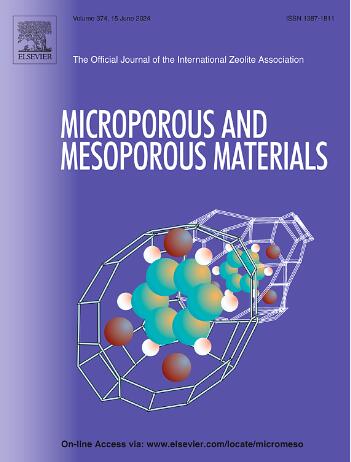Hydrothermal synthesis of mesoporous cerium oxide nanoparticles with improved properties by niobium doping
IF 4.8
3区 材料科学
Q1 CHEMISTRY, APPLIED
引用次数: 0
Abstract
Nanostructured materials exhibit remarkable properties, making them promising candidates for effluent treatment applications. The doped compounds can further enhance their efficiency. Herein, cerium and niobium-based nanomaterials were synthesized using an easy hydrothermal method for application in effluent treatment. Materials with different Ce:Nb molar ratios were produced and characterized using various techniques, including X-ray fluorescence, powder X-ray diffraction, adsorption-desorption isotherms of N2, Raman spectroscopy, electron paramagnetic resonance spectroscopy, thermogravimetric analysis, scanning electron microscopy combined with energy-dispersive X-ray spectroscopy, and UV–Vis diffuse reflectance spectroscopy. The results confirmed the incorporation of niobium into the structures of the materials, which showed mesoporous characteristics, and the Rietveld refinement shows a decrease in lattice parameters, suggesting that niobium replaces some Ce ions in the CeO2 structure. A higher niobium ratio led to a larger pore diameter but a smaller surface area. Additionally, the materials exhibited absorption in the UV region and a bandgap between 2.75 and 2.85 eV, demonstrating their potential for use in photocatalytic reactions. The materials were tested for oxidation of dye compounds under ultraviolet and visible light, and the results showed a tremendous oxidative potential. The best condition presented 100 % degradation after 60 min of reaction, and after five reaction cycles, it was kept above 90 % removal. Mass spectrometry with electrospray ionization (ESI-MS) spectra and total organic carbon (TOC) rate showed the high oxidation rate of the dye. So, niobium doping in cerium oxide showed an increased catalytic potential, which does not require catalytic support or a semiconductor for photocatalysis reactions.

通过掺杂铌水热合成性能更好的介孔氧化铈纳米粒子
纳米结构材料表现出非凡的性能,使其成为污水处理应用的有希望的候选者。掺杂后的化合物可以进一步提高其效率。本文采用简单的水热法合成了铈和铌基纳米材料,并将其应用于污水处理。采用x射线荧光、粉末x射线衍射、N2吸附-解吸等温线、拉曼光谱、电子顺磁共振光谱、热重分析、扫描电镜结合能量色散x射线光谱、紫外-可见漫反射光谱等技术,制备了不同Ce:Nb摩尔比的材料,并对其进行了表征。结果证实了铌的加入使材料的结构呈现出介孔特征,Rietveld细化显示出晶格参数的减小,表明铌取代了CeO2结构中的部分Ce离子。铌比越高,孔隙直径越大,比表面积越小。此外,材料在紫外区表现出吸收,带隙在2.75 ~ 2.85 eV之间,证明了它们在光催化反应中的应用潜力。在紫外光和可见光下对染料化合物进行了氧化测试,结果表明该材料具有很强的氧化潜力。反应60 min后,最佳条件为100%降解,5次循环后,去除率保持在90%以上。电喷雾电离(ESI-MS)质谱和总有机碳(TOC)率表明染料具有较高的氧化率。因此,铌掺杂在氧化铈中表现出更高的催化电位,而光催化反应不需要催化载体或半导体。
本文章由计算机程序翻译,如有差异,请以英文原文为准。
求助全文
约1分钟内获得全文
求助全文
来源期刊

Microporous and Mesoporous Materials
化学-材料科学:综合
CiteScore
10.70
自引率
5.80%
发文量
649
审稿时长
26 days
期刊介绍:
Microporous and Mesoporous Materials covers novel and significant aspects of porous solids classified as either microporous (pore size up to 2 nm) or mesoporous (pore size 2 to 50 nm). The porosity should have a specific impact on the material properties or application. Typical examples are zeolites and zeolite-like materials, pillared materials, clathrasils and clathrates, carbon molecular sieves, ordered mesoporous materials, organic/inorganic porous hybrid materials, or porous metal oxides. Both natural and synthetic porous materials are within the scope of the journal.
Topics which are particularly of interest include:
All aspects of natural microporous and mesoporous solids
The synthesis of crystalline or amorphous porous materials
The physico-chemical characterization of microporous and mesoporous solids, especially spectroscopic and microscopic
The modification of microporous and mesoporous solids, for example by ion exchange or solid-state reactions
All topics related to diffusion of mobile species in the pores of microporous and mesoporous materials
Adsorption (and other separation techniques) using microporous or mesoporous adsorbents
Catalysis by microporous and mesoporous materials
Host/guest interactions
Theoretical chemistry and modelling of host/guest interactions
All topics related to the application of microporous and mesoporous materials in industrial catalysis, separation technology, environmental protection, electrochemistry, membranes, sensors, optical devices, etc.
 求助内容:
求助内容: 应助结果提醒方式:
应助结果提醒方式:


